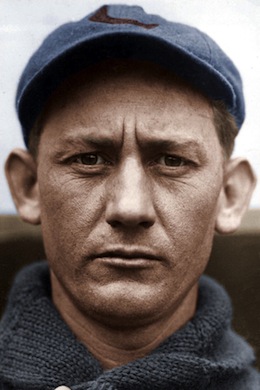September 29, 1915: Gene Packard does it all for Packers, wins 20th game in pennant race
 A large crowd of 6,000 turned out to watch the St. Louis Terriers face the Kansas City Packers in the final week of the red-hot 1915 Federal League pennant race. Five teams had battled throughout the summer and had all been within 4½games of the lead as late as September 1. By month’s end, Newark and Kansas City had fallen out of contention but a scant .015 separated the trio of Pittsburgh, Chicago, and St. Louis. The Terriers were a half-game behind the Smoky City’s Rebels with the Whales a half-game further back.
A large crowd of 6,000 turned out to watch the St. Louis Terriers face the Kansas City Packers in the final week of the red-hot 1915 Federal League pennant race. Five teams had battled throughout the summer and had all been within 4½games of the lead as late as September 1. By month’s end, Newark and Kansas City had fallen out of contention but a scant .015 separated the trio of Pittsburgh, Chicago, and St. Louis. The Terriers were a half-game behind the Smoky City’s Rebels with the Whales a half-game further back.
So the stakes were high as St. Louis opened its final series at home against its in-state rivals. The Terriers’ manager, Fielder Jones, sent right-hander Dave Davenport to the hill. Davenport was one of three Terriers 20-game winners and his fastball was aided by a 6-foot-6 frame. He would lead the Federal League in strikeouts in 1915 and finish seventh in walks. Kansas City was no longer in the race but manager George Stovall opened with one of his top pitchers as well. At 5-feet-10 and 155 pounds, Gene Packard was tiny compared to his opponent but he could also get strikeouts, as evidenced by a top-10 finish in 1914.
Davenport took the mound and gave up a leadoff single to Chet Chadbourne. Pep Goodwin hit into a force and then was gunned down by Grover Hartley, and that was the closest a Packer would get to safely touching second base until the sixth inning. Packard was equally effective, walking only one batter and scattering four singles, although Duke Kenworthy saved him with a strong throw to nail Jack Tobin at the plate in the second.
The game sailed along and finished in a mere hour and 10 minutes as batter after batter made out and returned to their benches.1 Both starters pounded the zone and pitched to contact as evidenced by the 16 putouts racked up by each first baseman. Packard struck out four in addition to his lone base on balls, and the hard-throwing Davenport recorded neither statistic.
The St. Louis hurler made only one real mistake and it occurred in the top of the sixth inning with his counterpart at bat. Packard batted .232 that season and with one man out and the bases empty there seemed little danger. At least not until the slender Packard “walloped one of Davenport’s shoots over the right field wall for a home run.”2 The crowd at Handlan’s Park was stunned as a Kansas City batsman finally touched second base on his way to score. Packard hit only that single home run in 1915 and it was devastating to the Terriers cause.
Kansas City did not threaten again but the home nine could not break through either. Davenport left after eight innings, pinch-hit for by Doc Crandall, who “dropped a Texas leaguer over Stovall’s periscope” into right.3 That threat died when Bobby Vaughn lined to third and George Perring knocked the ball down and threw to second for the force. Crandall then pitched a flawless ninth and the Terriers went at Packard one last time.
After Jimmy Walsh pinch-hit unsuccessfully for Ward Miller, Armando Marsans ran the count to 2-and-2 before spinning away from an inside pitch. The Cuban shouted that he had been hit and both Jones and on-deck hitter Babe Borton came out to argue for a desperately needed baserunner. Umpire Barry McCormick disagreed, however, and Marsans had to bat and topped the ball back to Packard on the full-count pitch.4
Jones called back Borton and sent Hughie Miller to the plate but the substitute quickly went down swinging to end the game. The large crowd filed disappointedly out of the stands but Chicago’s 6-3 victory over Pittsburgh took some of the sting out of the loss.
At the end of the day, the Rebels remained in the lead by the wafer-thin margin of .003 over the Whales. The Terriers had dropped to third but were only .005 and a half-game behind Pittsburgh as one of the closest pennant chases in baseball history moved toward its climax. Packard did not start another FL game. He parlayed his second consecutive 20-win season into a four-year stint in the National League.
The Terriers finished even with Chicago but a heartbreaking .001 behind in the standings with Fielder Jones ruing the surprise home run that cost his team the pennant.
Sources
In addition to the sources cited in the Notes, the author also consulted Retrosheet.org.
Notes
1 “Packard Won Own Game,” Kansas City Star, September 30, 1915: 6.
2 “Pitcher Packard’s Homer Crowns a Splendid Twirling Feat By K.C. Star,” St. Louis Dispatch, September 30, 1915: 19.
3 Kansas City Star.
4 St. Louis Dispatch. The reporter wrote that from his viewpoint in the grandstand, the ball did not appear to hit Marsans.
Additional Stats
Kansas City Packers 1
St. Louis Terriers 0
Handlan’s Park
St. Louis, MO
Box Score + PBP:
Corrections? Additions?
If you can help us improve this game story, contact us.

